Building a Team and Process to Reduce CAUTI Risk
Slide Presentation
Slide 1

Mohamad Fakih, MD, MPH
Professor of Medicine
Wayne State University School of Medicine
Medical Director, Infection Prevention and Control
St. John Hospital and Medical Center
Barbara Lucas, MD, MHSA
Project Consultant
Michigan Health & Hospital Association
Keystone Center for Patient Safety and Quality
Images: Photos of Drs. Fakih and Lucas.
Slide 2
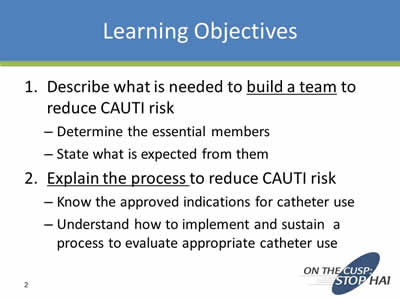
Learning Objectives
- Describe what is needed to build a team to reduce CAUTI risk:
- Determine the essential members
- State what is expected from them:
- Explain the process to reduce CAUTI risk:
- Know the approved indications for catheter use
- Understand how to implement and sustain a process to evaluate appropriate catheter use
Slide 3

Building a Successful Team: Why Are We Doing This?
Two Goals for the CAUTI Collaborative:
- Improve the culture of safety on your unit through the Comprehensive Unit-based Safety Program (CUSP)
- Reduce your unit’s CAUTI rate by 25%
Both goals require strong commitment at the organizational leadership and unit level!
Slide 4
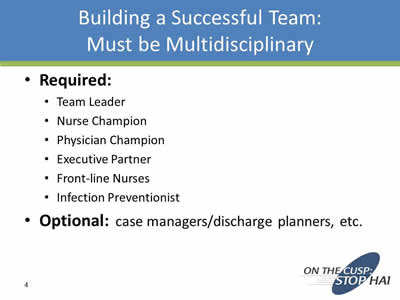
Building a Successful Team: Must be Multidisciplinary
- Required:
- Team Leader
- Nurse Champion
- Physician Champion
- Executive Partner
- Front-line Nurses
- Infection Preventionist
- Optional: case managers/discharge planners, etc.
Slide 5

Building a Successful Team: The Team Leader
- Ideal Characteristics:
- Opinion leader, with demonstrated commitment to patient safety
- Team player, respected by others, empowered by leadership
- Strong organizational, management, and communication skills
- Role Expectations:
- Recruit team members and define team roles
- Understand and clearly articulate project goals
- Delegate tasks and hold others accountable
- Lead team meetings and participate in collaborative activities to meet project requirements
- Track project progress
Slide 6
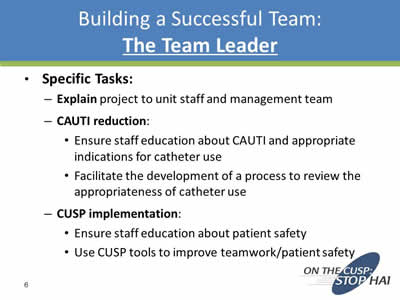
Building a Successful Team: The Team Leader
- Specific Tasks:
- Explain project to unit staff and management team
- CAUTI reduction:
- Ensure staff education about CAUTI and appropriate indications for catheter use:
- Facilitate the development of a process to review the appropriateness of catheter use
- CUSP implementation:
- Ensure staff education about patient safety
- Use CUSP tools to improve teamwork/patient safety
Slide 7
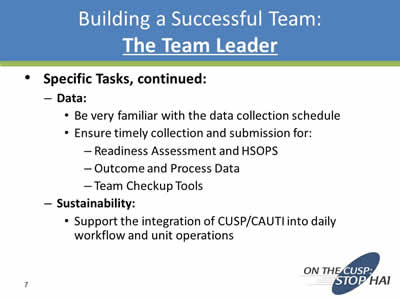
Building a Successful Team: The Team Leader
- Specific Tasks, continued:
- Data:
- Be very familiar with the data collection schedule
- Ensure timely collection and submission for:
- Readiness Assessment and HSOPS
- Outcome and Process Data
- Team Checkup Tools
- Sustainability:
- Support the integration of CUSP/CAUTI into daily workflow and unit operations
- Data:
Slide 8
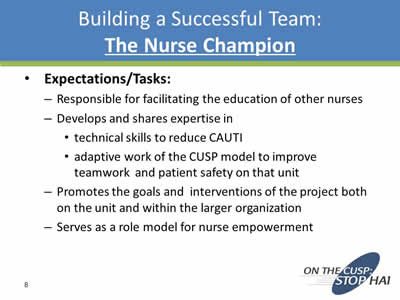
Building a Successful Team: The Nurse Champion
- Expectations/Tasks:
- Responsible for facilitating the education of other nurses
- Develops and shares expertise in:
- Technical skills to reduce CAUTI
- Adaptive work of the CUSP model to improve teamwork and patient safety on that unit
- Promotes the goals and interventions of the project both on the unit and within the larger organization
- Serves as a role model for nurse empowerment
Slide 9
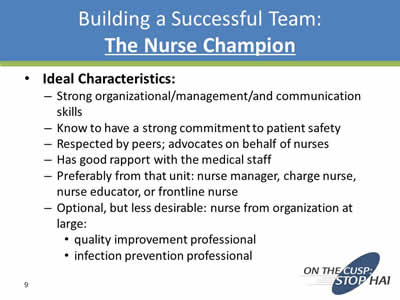
Building a Successful Team: The Nurse Champion
- Ideal Characteristics:
- Strong organizational/management/and communication skills
- Know to have a strong commitment to patient safety
- Respected by peers; advocates on behalf of nurses
- Has good rapport with the medical staff
- Preferably from that unit: nurse manager, charge nurse, nurse educator, or frontline nurse
- Optional, but less desirable: nurse from organization at large:
- Quality improvement professional
- Infection prevention professional
Slide 10
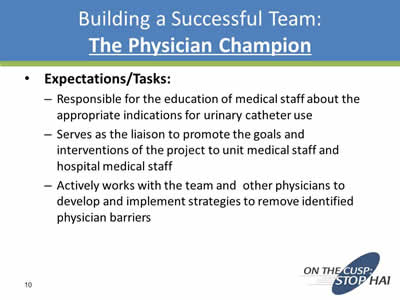
Building a Successful Team: The Physician Champion
- Expectations/Tasks:
- Responsible for the education of medical staff about the appropriate indications for urinary catheter use
- Serves as the liaison to promote the goals and interventions of the project to unit medical staff and hospital medical staff
- Actively works with the team and other physicians to develop and implement strategies to remove identified physician barriers
Slide 11

Building a Successful Team: The Physician Champion
- Ideal Characteristics:
- Strong communication and quality improvement skills
- Empowered by leadership
- Respected by medical staff peers and nursing staff
- Demonstrates a spirit of collegiality to all team members
- Possible choices: Urologist, infectious disease specialist, hospitalist, quality/patient safety officer or any physician interested in improving safety and quality
Slide 12
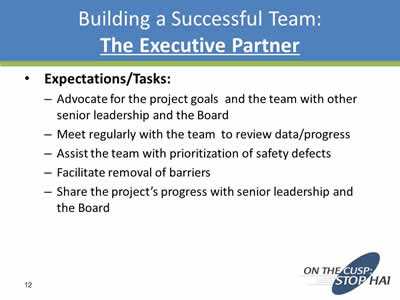
Building a Successful Team: The Executive Partner
- Expectations/Tasks:
- Advocate for the project goals and the team with other senior leadership and the Board
- Meet regularly with the team to review data/progress
- Assist the team with prioritization of safety defects
- Facilitate removal of barriers
- Share the project’s progress with senior leadership and the Board
Slide 13
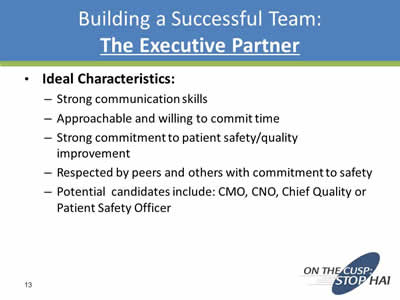
Building a Successful Team: The Executive Partner
- Ideal Characteristics:
- Strong communication skills
- Approachable and willing to commit time
- Strong commitment to patient safety/quality improvement
- Respected by peers and others with commitment to safety
- Potential candidates include: CMO, CNO, Chief Quality or Patient Safety Officer
Slide 14
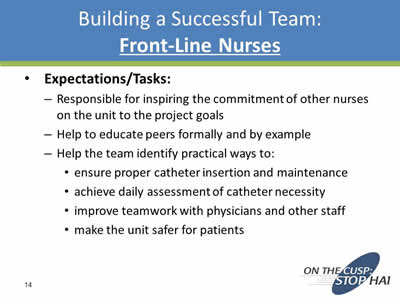
Building a Successful Team: Front-Line Nurses
- Expectations/Tasks:
- Responsible for inspiring the commitment of other nurses on the unit to the project goals
- Help to educate peers formally and by example
- Help the team identify practical ways to:
- Ensure proper catheter insertion and maintenance
- Achieve daily assessment of catheter necessity
- Improve teamwork with physicians and other staff
- Make the unit safer for patients
Slide 15
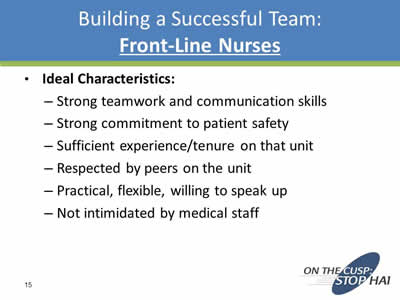
Building a Successful Team: Front-Line Nurses
- Ideal Characteristics:
- Strong teamwork and communication skills
- Strong commitment to patient safety
- Sufficient experience/tenure on that unit
- Respected by peers on the unit
- Practical, flexible, willing to speak up
- Not intimidated by medical staff
Slide 16
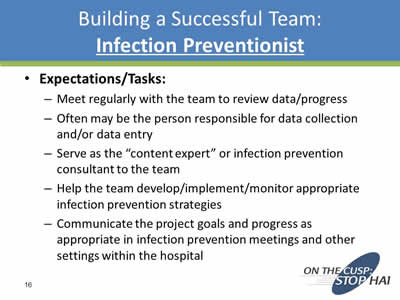
Building a Successful Team: Infection Preventionist
- Expectations/Tasks:
- Meet regularly with the team to review data/progress
- Often may be the person responsible for data collection and/or data entry
- Serve as the “content expert” or infection prevention consultant to the team
- Help the team develop/implement/monitor appropriate infection prevention strategies
- Communicate the project goals and progress as appropriate in infection prevention meetings and other settings within the hospital
Slide 17
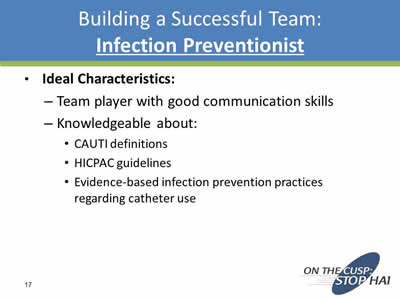
Building a Successful Team: Infection Preventionist
- Ideal Characteristics:
- Team player with good communication skills
- Knowledgeable about:
- CAUTI definitions
- HICPAC guidelines
- Evidence-based infection prevention practices regarding catheter use
Slide 18
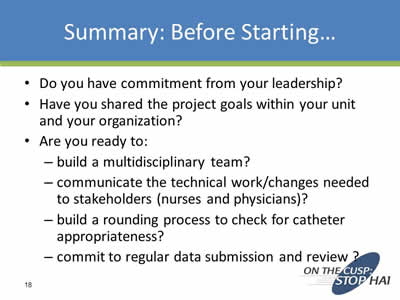
Summary: Before Starting…
- Do you have commitment from your leadership?
- Have you shared the project goals within your unit and your organization?
- Are you ready to:
- Build a multidisciplinary team?
- Communicate the technical work/changes needed to stakeholders (nurses and physicians)?
- Build a rounding process to check for catheter appropriateness?
- Commit to regular data submission and review ?
Slide 19

Summary: To Be Successful…
To achieve BOTH project goals of improving your unit safety culture and reducing CAUTI’s you will need:
- A multidisciplinary, unit level team
- Strong backing from organizational leadership
- A respected and effective team leader
- A committed physician and nursing champion
- Nursing AND physician ownership of the work to make care safer for patients
Slide 20
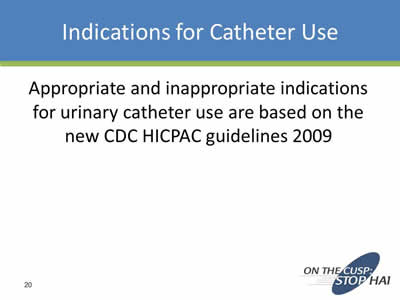
Indications for Catheter Use
Appropriate and inappropriate indications for urinary catheter use are based on the new CDC HICPAC guidelines 2009
Slide 21
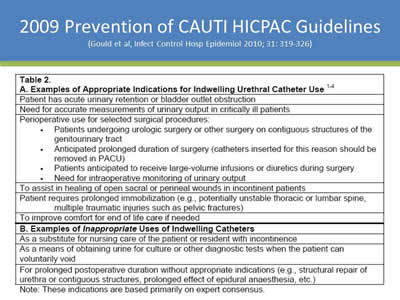
2009 Prevention of CAUTI HICPAC Guidelines
(Gould et al, Infect Control Hosp Epidemiol 2010; 31: 319-326)
Image: Table: The 2009 CAUTI HICPAC Guidelines specify both appropriate indications for indwelling urethral catheter use and inappropriate indications. Appropriate indications include urinary retention or bladder outlet obstruction, need for accurate measurements of urinary output in critically ill patients, and perioperative use for selected surgical procedures. Examples of inappropriate uses for indwelling catheters include means of obtaining urine for culture when the patient can voluntarily void and for prolonged postoperative duration without appropriate indications.
Slide 22
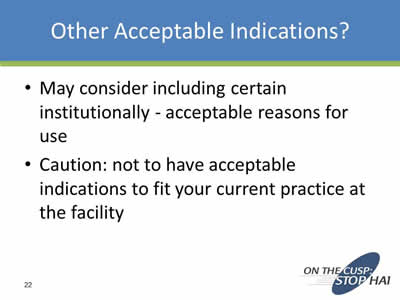
Other Acceptable Indications?
- May consider including certain institutionally - acceptable reasons for use
- Caution: not to have acceptable indications to fit your current practice at the facility
Slide 23

Other Acceptable Indications?
- A more helpful approach would be to have more clarity established at your institution on what each of the indications means
Slide 24
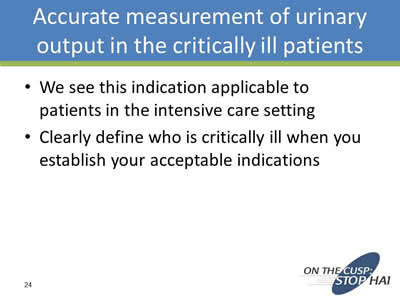
Accurate Measurement of Urinary Output in the Critically Ill Patients
- We see this indication applicable to patients in the intensive care setting
- Clearly define who is critically ill when you establish your acceptable indications
Slide 25
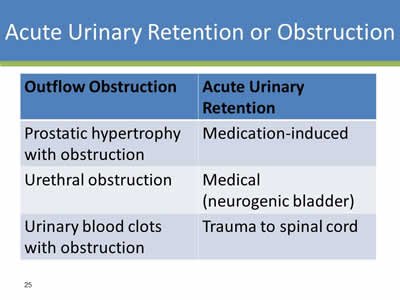
Acute Urinary Retention or Obstruction
| Outflow Obstruction | Acute Urinary Retention |
|---|---|
| Prostatic hypertrophy with obstruction | Medication-induced |
| Urethral obstruction | Medical (neurogenic bladder) |
| Urinary blood clots with obstruction | Trauma to spinal cord |
Slide 26
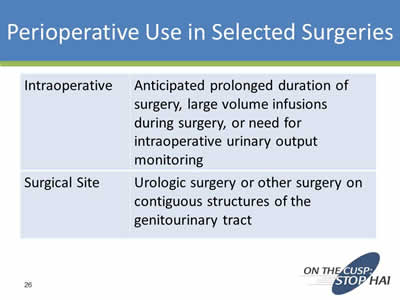
Perioperative Use in Selected Surgeries
| Interoperative | Anticipated prolonged duration of surgery, large volume infusions during surgery, or need for intraoperative urinary output monitoring |
| Surgical Site | Anticipated prolonged duration of surgery, large volume infusions during surgery, or need for intraoperative urinary output monitoring |
Slide 27
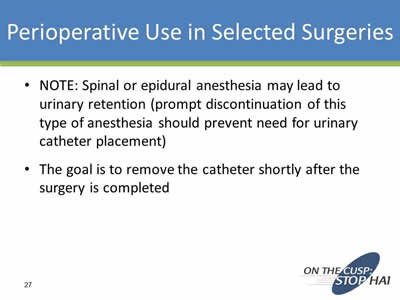
Perioperative Use in Selected Surgeries
- Note: Spinal or epidural anesthesia may lead to urinary retention (prompt discontinuation of this type of anesthesia should prevent need for urinary catheter placement)
- The goal is to remove the catheter shortly after the surgery is completed
Slide 28

Assist Healing of Perineal and Sacral Wounds in Incontinent Patients
- This is an indication when there is concern that urinary incontinence is leading to worsening skin integrity in areas where there is skin breakdown.
Slide 29
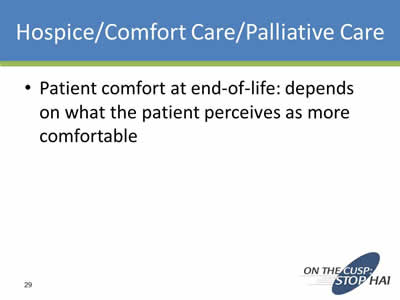
Hospice/Comfort Care/Palliative Care
- Patient comfort at end-of-life: depends on what the patient perceives as more comfortable
Slide 30
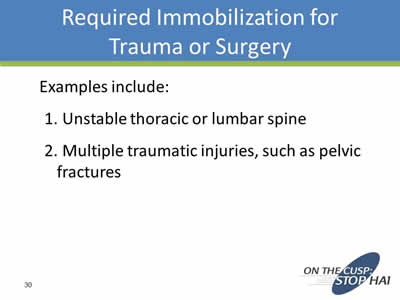
Required Immobilization for Trauma or Surgery
Examples include:
- Unstable thoracic or lumbar spine
- Multiple traumatic injuries, such as pelvic fractures
Slide 31
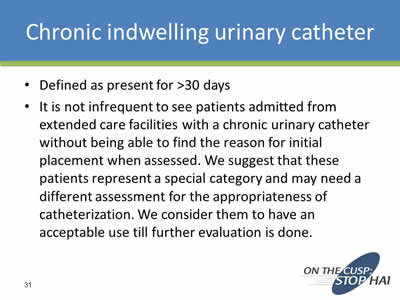
Chronic Indwelling Urinary Catheter
- Defined as present for >30 days
- It is not infrequent to see patients admitted from extended care facilities with a chronic urinary catheter without being able to find the reason for initial placement when assessed. We suggest that these patients represent a special category and may need a different assessment for the appropriateness of catheterization. We consider them to have an acceptable use till further evaluation is done.
Slide 32
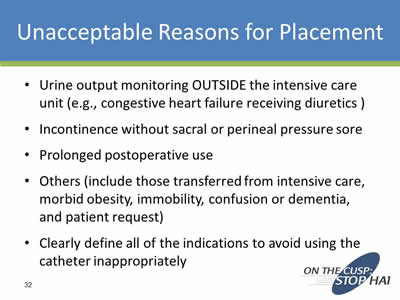
Unacceptable Reasons for Placement
- Urine output monitoring OUTSIDE the intensive care unit (e.g., congestive heart failure receiving diuretics)
- Incontinence without sacral or perineal pressure sore
- Prolonged postoperative use
- Others (include those transferred from intensive care, morbid obesity, immobility, confusion or dementia, and patient request)
- Clearly define all of the indications to avoid using the catheter inappropriately
Slide 33
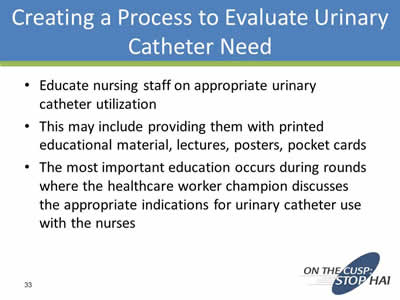
Creating a Process to Evaluate Urinary Catheter Need
- Educate nursing staff on appropriate urinary catheter utilization
- This may include providing them with printed educational material, lectures, posters, pocket cards
- The most important education occurs during rounds where the healthcare worker champion discusses the appropriate indications for urinary catheter use with the nurses
Slide 34
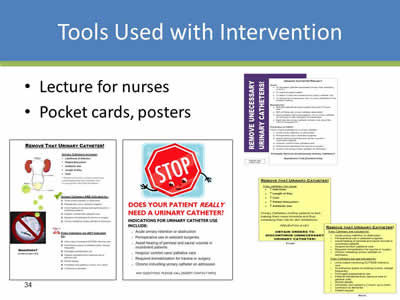
Tools Used with Intervention
- Lecture for nurses
- Pocket cards, posters
Images: Example pictures of posters and pocket cards that can used with the intervention.
Slide 35
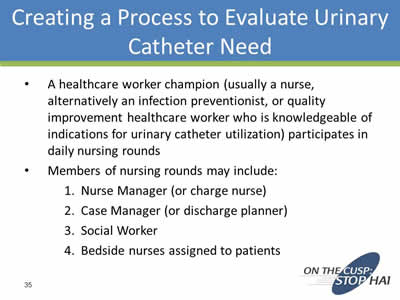
Creating a Process to Evaluate Urinary Catheter Need
- A healthcare worker champion (usually a nurse, alternatively an infection preventionist, or quality improvement healthcare worker who is knowledgeable of indications for urinary catheter utilization) participates in daily nursing rounds
- Members of nursing rounds may include:
- Nurse Manager (or charge nurse)
- Case Manager (or discharge planner)
- Social Worker
- Bedside nurses assigned to patients
Slide 36
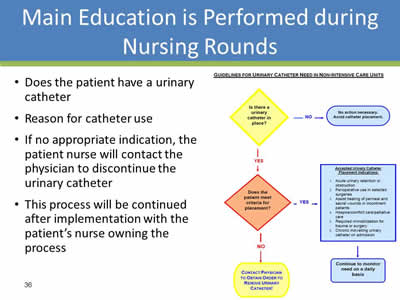
Main Education is Performed During Nursing Rounds
- Does the patient have a urinary catheter
- Reason for catheter use
- If no appropriate indication, the patient nurse will contact the physician to discontinue the urinary catheter
- This process will be continued after implementation with the patient’s nurse owning the process
Image: Flowchart called "Guidelines for Urinary Catheter Need in Non-Intensive Care Units".
Slide 37
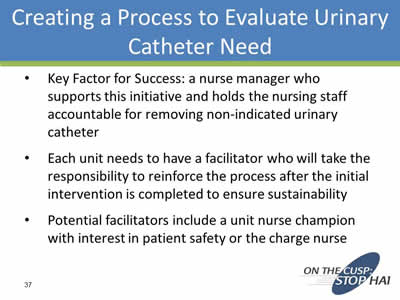
Catheter Need
- Key Factor for Success: a nurse manager who supports this initiative and holds the nursing staff accountable for removing non-indicated urinary catheter
- Each unit needs to have a facilitator who will take the responsibility to reinforce the process after the initial intervention is completed to ensure sustainability
- Potential facilitators include a unit nurse champion with interest in patient safety or the charge nurse
Slide 38
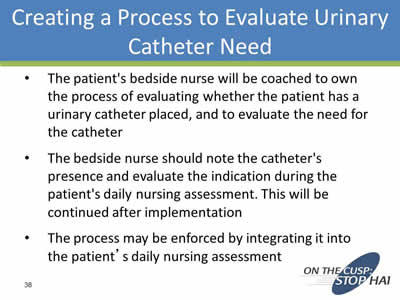
Creating a Process to Evaluate Urinary Catheter Need
- The patient's bedside nurse will be coached to own the process of evaluating whether the patient has a urinary catheter placed, and to evaluate the need for the catheter
- The bedside nurse should note the catheter's presence and evaluate the indication during the patient's daily nursing assessment. This will be continued after implementation
- The process may be enforced by integrating it into the patient’s daily nursing assessment
Slide 39
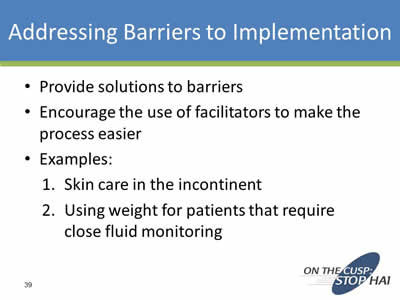
Addressing Barriers to Implementation
- Provide solutions to barriers
- Encourage the use of facilitators to make the process easier
- Examples:
- Skin care in the incontinent
- Using weight for patients that require close fluid monitoring
Slide 40

What If There Are No Nursing Rounds? Options?
- The nurse champion discusses with each nurse on the unit the presence and need of the catheter
- Alternatively, nurse champion and mid level provider may round on patients to evaluate presence, need, and discontinue catheter if no need
Slide 41
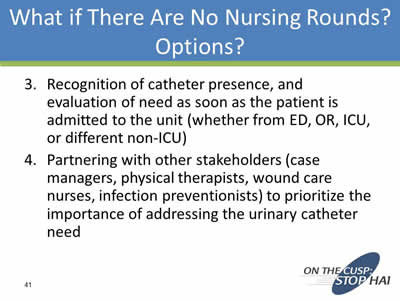
What If There Are No Nursing Rounds? Options?
- Recognition of catheter presence, and evaluation of need as soon as the patient is admitted to the unit (whether from ED, OR, ICU, or different non-ICU)
- Partnering with other stakeholders (case managers, physical therapists, wound care nurses, infection preventionists) to prioritize the importance of addressing the urinary catheter need
Slide 42
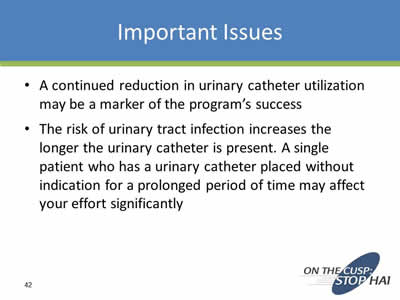
Important Issues
- A continued reduction in urinary catheter utilization may be a marker of the program’s success
- The risk of urinary tract infection increases the longer the urinary catheter is present. A single patient who has a urinary catheter placed without indication for a prolonged period of time may affect your effort significantly
Slide 43
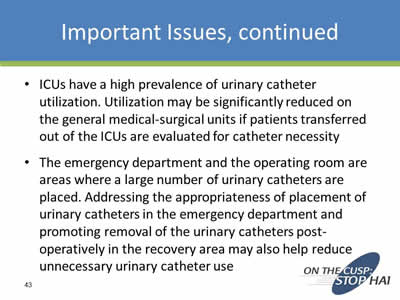
Important Issues, continued
- ICUs have a high prevalence of urinary catheter utilization. Utilization may be significantly reduced on the general medical-surgical units if patients transferred out of the ICUs are evaluated for catheter necessity
- The emergency department and the operating room are areas where a large number of urinary catheters are placed. Addressing the appropriateness of placement of urinary catheters in the emergency department and promoting removal of the urinary catheters post-operatively in the recovery area may also help reduce unnecessary urinary catheter use
Slide 44
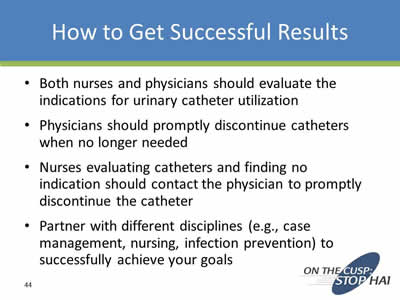
How to Get Successful Results
- Both nurses and physicians should evaluate the indications for urinary catheter utilization
- Physicians should promptly discontinue catheters when no longer needed
- Nurses evaluating catheters and finding no indication should contact the physician to promptly discontinue the catheter
- Partner with different disciplines (e.g., case management, nursing, infection prevention) to successfully achieve your goals
Slide 45
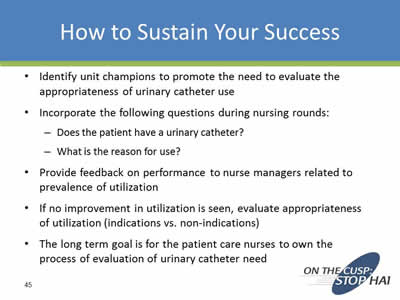
How to Sustain Your Success
- Identify unit champions to promote the need to evaluate the appropriateness of urinary catheter use
- Incorporate the following questions during nursing rounds:
- Does the patient have a urinary catheter?
- What is the reason for use?
- Provide feedback on performance to nurse managers related to prevalence of utilization
- If no improvement in utilization is seen, evaluate appropriateness of utilization (indications vs. non-indications)
- The long term goal is for the patient care nurses to own the process of evaluation of urinary catheter need
Slide 46
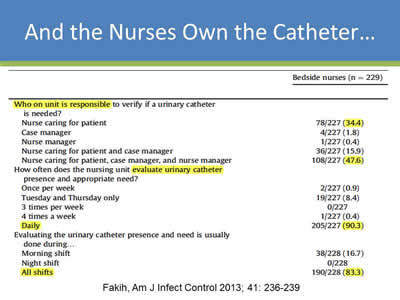
And the Nurses Own the Catheter…
Bedside nurses (n = 229)
| Who on unit is responsible to verify if a urinary catheter is needed? | |
| Nurse caring for patient | 78/227 (34.4) |
| Case manager | 4/227 (1.8) |
| Nurse caring for patient and case manager | 1/227 (0.4) |
| Nurse caring for patient, case managger, and nurse manager | 108/227 (47.6) |
| How often does the nursing unit evaluate urinary catheter presence and appropriate need? | |
| Once per week | 2/227 (0.9) |
| Tuesday and Thursday only | 19/227 (8.4) |
| 3 times per week | 0/227 |
| 4 times a week | 1/227 (0.4) |
| Daily | 205/227 (90.3) |
| Evaluating the urinary catheter presence and need is usually done during... | |
| Morning shift | 38/228 (16.7) |
| Night shift | 0/228 |
| All shifts | 190/228 (83.3) |
Fakih, Am J Infect Control 2013; 41: 236-239.
Slide 47
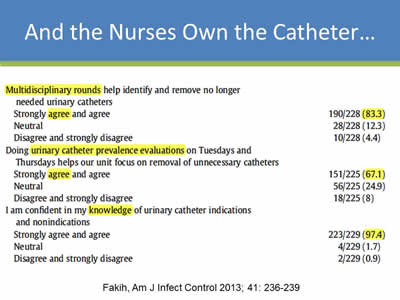
And the Nurses Own the Catheter…
| Multidisciplinary rounds help identify and remove no longer needed urinary catheters | |
| Strongly agree and agree | 190/228 (83.3) |
| Neutral | 28/228 (12.3) |
| Disagree and strongly disagree | 10/228 (4.4) |
| Doing urinary catheter prevalence evaluations on Tuesdays and Thursdays helps our unit focus on removal of unnecessary catheters | |
| Strongly agree and agree | 151/225 (67.1) |
| Neutral | 56/225 (24.9) |
| Disagree and strongly disagree | 18/225 (8) |
| I am confident in my knowledge of urinary catheter indications | |
| Strongly agree and agree | 223/229 (97.4) |
| Neutral | 4/229 (1.7) |
| Disagree and strongly disagree | 2/229 (0.9) |
Fakih, Am J Infect Control 2013; 41: 236-239.
Slide 48
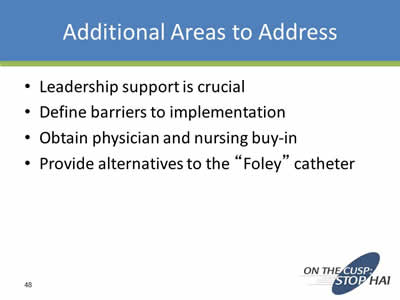
Additional Areas to Address
- Leadership support is crucial
- Define barriers to implementation
- Obtain physician and nursing buy-in
- Provide alternatives to the “Foley” catheter
Slide 49

Think About the Whole Picture: Areas to Address
Image: Flowchart showing different facets of areas to address. PACU/OR, ICU, and ED all point to Non-ICU issues.
PACU/OR
- Remove promptly after surery before transfer out
ICU
- Evaluate for continued need
- Discontinue no longer needed before transfer
ED
- Avoid initial placement
- Reevaluate for continued need after patient stabilizes
Non-ICU
- Evaluate need on admission
- Evaluate for continued need
Slide 50

Thank you!
Questions?
Slide 51
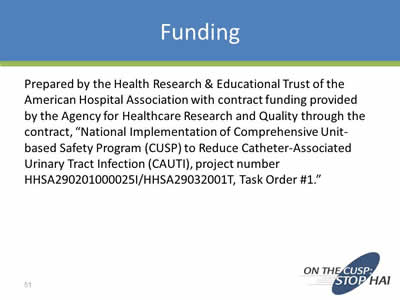
Funding
Prepared by the Health Research & Educational Trust of the American Hospital Association with contract funding provided by the Agency for Healthcare Research and Quality through the contract, “National Implementation of Comprehensive Unit-based Safety Program (CUSP) to Reduce Catheter-Associated Urinary Tract Infection (CAUTI), project number HHSA290201000025I/HHSA29032001T, Task Order #1.”



